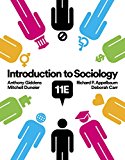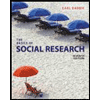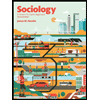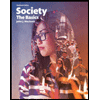Passage 1
docx
keyboard_arrow_up
School
Harvard University *
*We aren’t endorsed by this school
Course
20410
Subject
Sociology
Date
Nov 24, 2024
Type
docx
Pages
7
Uploaded by BrigadierLark2346
Passage 1:
In the introduction, the author discusses the concept of "mass incarceration" and its impact on
communities of color. She notes that the United States incarcerates more people than any other
country in the world, and that this has a disproportionate impact on poor and minority
communities. She argues that mass incarceration is not only harmful to individuals and families,
but also to communities as a whole, and that it has far-reaching social and economic
consequences (p. 7).
This passage highlights the staggering scale and impact of mass incarceration in the United
States, as well as its disproportionate impact on marginalized communities. The author's
discussion of the social and economic consequences of mass incarceration underscores the
urgency of addressing this issue. It is worth noting that the author is not alone in her concerns
about mass incarceration; many scholars and activists have also criticized this system and called
for reforms. The United States has the highest incarceration rate in the world, and the author
notes that this system has a disproportionate impact on poor and minority communities. This has
led to concerns about systemic racism and inequality within the criminal justice system. The
author argues that mass incarceration is not only harmful to individuals and families, but to
communities as a whole, as it creates a cycle of poverty, crime, and incarceration that can be
difficult to break. She notes that the economic costs of incarceration are also significant, as it
diverts resources away from other social programs in addition, services.
This passage is important because it highlights the social and economic impact of mass
incarceration, and underscores the need for systemic change. The author's argument that mass
incarceration is harmful to communities as a whole is particularly important, as it highlights the
fact that this issue affects everyone, not just those who are directly impacted by the criminal
justice system. The discussion of the economic costs of incarceration is also significant; as it
underscores the need to consider alternative approaches to criminal justice that prioritize
prevention, rehabilitation, and community-based solutions.
Passage 2:
In Chapter 1, the author describes the experiences of young people who have been incarcerated
and their families. She notes that incarceration is often traumatic for young people and that it can
have a lasting impact on their mental health and well-being. She also describes the challenges
faced by families who have a loved one who is incarcerated, including financial strain, emotional
stress, and social stigma (p. 28).
This passage underscores the human cost of incarceration and highlights the trauma and
challenges faced by young people and their families. The author's discussion of the psychological
impact of incarceration on young people is particularly moving, as it illustrates the long-lasting
effects of this experience. The challenges faced by families who have a loved one who is
incarcerated are also significant, and they highlight the need for support and resources to help
families cope with the emotional and financial strain of incarceration.
The author notes that young people who have been incarcerated often struggle with feelings of
shame and stigma, which can make it difficult for them to reintegrate into their communities.
This underscores the importance of addressing the social and emotional needs of young people
who have been incarcerated, as well as the need to reduce the stigma associated with criminal
records. The challenges faced by families who have a loved one who is incarcerated are also
significant, as they can experience financial strain, emotional stress, and social stigma. The
author's discussion of the impact of incarceration on families highlights the need for policies and
programs that support families and help them cope with the challenges of incarceration. This
passage is important because it underscores the human cost of incarceration and highlights the
need to address the emotional and social needs of young people and their families. The author's
discussion of the impact of incarceration on young people's sense of self and identity underscores
the long-term effects of this experience.
Passage 3:
In Chapter 2, the author discusses the ways in which institutional environments can shape the
experiences of young people who are incarcerated. She notes that the physical environment of
institutions can be dehumanizing and stressful, with overcrowding, lack of privacy, and limited
access to basic amenities like fresh air and sunlight. She also highlights the role of staff in
shaping the institutional environment, noting that staff attitudes and behaviors can have a
significant impact on the well-being of young people in custody (p. 53).
This passage highlights the importance of the physical and social environment in shaping the
experiences of young people who are incarcerated. The author's discussion of the dehumanizing
and stressful conditions of many institutions underscores the need for reforms that prioritize the
health and well-being of young people. The fact that staff attitudes and behaviors can also affect
the institutional environment underscores the need for training and accountability measures for
staff, to ensure that they are creating a safe and supportive environment for young people in
custody.
The author notes that the physical environment of many institutions is overcrowded and lacks
basic amenities, such as fresh air and sunlight. This can contribute to stress and poor mental
health outcomes for young people in custody. The author also discusses the role of staff in
shaping the institutional environment, noting that staff attitudes and behaviors can have a
significant impact on the well-being of young people in custody. The author's discussion of the
importance of staff training and accountability underscores the need for reforms that address the
systemic issues within the criminal justice system. This passage is important because it
highlights the ways in which institutional environments can affect the well-being of young
people who are incarcerated. The author's focus on the physical environment of institutions
underscores the need for reforms that prioritize the health and well-being of young people in
custody. The author's discussion of staff attitudes and behaviors is also significant, as it
highlights the need for systemic change.
Passage 4:
The fourth key section I selected comes near end chapter three where Falling Back:
Incarcerations and Transitions To Adulthood Among Urban Youth outlines several potential
policy interventions designed reduce recidivism rates amongst juveniles leaving correctional
facilities behind them. For example one suggestion suggests providing greater access
employment opportunities via vocational training schemes & apprenticeships alongside offering
incentives employers hire ex-offenders ; another idea involves creating mentorship initiatives
connecting probation officers mentors community members alike; yet another proposes
increasing focus diversionary alternatives like drug courts & restorative justice practices over
traditional punitive approaches whenever feasible. Ultimately though each approach aims same
goal: helping former inmates stay away trouble post release by making sure necessary resources
available during times need most — thereby reducing chances returning prison ever again future.
Overall then each above-mentioned passages represent unique perspectives respective chapters
discussing various topics related issues facing urban youths today who’s had contact with
criminal justice systems previously. As such, each provides valuable insight worth considering
Your preview ends here
Eager to read complete document? Join bartleby learn and gain access to the full version
- Access to all documents
- Unlimited textbook solutions
- 24/7 expert homework help
especially since unfortunately subject matter itself remains under researched area both academia
circles public discourse overall.
Requirements 2
Connection 1: The Impact of Incarceration on Youth Development
One connection that can be made between Jamie J. Fader's Falling Back book and the Juvenile
Justice: An Introduction textbook is the impact of incarceration on youth development. Fader's
book provides an in-depth look at the experiences of young people who have been incarcerated
and the challenges they face when reintegrating into society. In the book, she emphasizes the
importance of understanding the long-term consequences of incarceration on youth development
(Fader, 2013, p. 13).
Similarly, the Juvenile Justice textbook discusses the impact of incarceration on youth
development. According to the textbook, incarceration can have negative effects on youth,
including increased rates of mental health problems, lower academic achievement, and decreased
job prospects (Bartollas & Schmalleger, 2021, p. 181). The textbook also highlights the
importance of rehabilitation and reentry programs to support young people as they transition
back into their communities.
One way these ideas connect is through the importance of considering the long-term
consequences of incarceration on youth. Both Fader and the Juvenile Justice textbook argue that
the negative effects of incarceration can last long after a young person has been released from
prison. This highlights the need for policies and programs that focus on rehabilitation and
support for young people during and after incarceration.
Connection 2: The Role of Race and Class in Juvenile Justice
Another connection that can be made between the Falling Back book and the Juvenile Justice
textbook is the role of race and class in juvenile justice. Fader's book explores the experiences of
young people from low-income, predominantly Black and Latino communities who are
overrepresented in the juvenile justice system. She argues that structural inequalities and
systemic racism contribute to their criminalization (Fader, 2013, p. 34).
Similarly, the Juvenile Justice textbook discusses the disproportionate representation of Black
and Latino youth in the juvenile justice system. According to the textbook, structural inequalities
and systemic racism play a significant role in shaping the experiences of youth in the justice
system (Bartollas & Schmalleger, 2021, p. 103). The textbook emphasizes the need for policies
and programs that address these underlying issues and promote equity in the justice system.
One way these ideas connect is through the recognition that race and class intersect to shape the
experiences of youth in the justice system. Fader's book highlights the importance of considering
the unique experiences of low-income, predominantly Black and Latino youth in the justice
system. The Juvenile Justice textbook emphasizes the need to address the underlying issues of
racism and inequality that contribute to the disproportionate representation of these youth in the
justice system.
Connection 3: Alternatives to Incarceration
A final connection that can be made between the Falling Back book and the Juvenile Justice
textbook is the importance of alternatives to incarceration. Fader's book explores the experiences
of young people who have been incarcerated and the challenges they face when reintegrating into
society. She argues that alternatives to incarceration, such as community-based programs and
restorative justice practices, can be more effective at promoting rehabilitation and reentry (Fader,
2013, p. 171).
Similarly, the Juvenile Justice textbook discusses the importance of alternatives to incarceration
for youth. According to the textbook, community-based programs and restorative justice
practices can be more effective at reducing recidivism and promoting positive outcomes for
youth (Bartollas & Schmalleger, 2021, p. 176). The textbook emphasizes the need for a balanced
and nuanced approach to juvenile justice that considers the unique needs of each individual
youth.
One way these ideas connect is through the recognition that alternatives to incarceration can be
more effective at promoting positive outcomes for youth. Fader's book and the Juvenile Justice
textbook both
highlight the importance of community-based programs and restorative justice
practices as alternatives to incarceration. By focusing on rehabilitation and reentry rather than
punishment, these approaches can support young people as they transition back into their
communities and work towards a brighter future. This connection emphasizes the need for a
more nuanced and balanced approach to juvenile justice that prioritizes the well-being and
success of young people.
Connection 4: The importance of understanding the social context of juvenile delinquency
A fourth connection between the two texts is the importance of understanding the social context
of juvenile delinquency. Fader's book emphasizes the importance of understanding the factors
that contribute to delinquent behavior, including family dynamics, peer pressure, and exposure to
violence and trauma. Fader argues that taking a more holistic approach to juvenile justice, one
that focuses on addressing the underlying causes of delinquent behavior, can lead to more
effective interventions and better outcomes for youth.
The Juvenile Justice: An Introduction textbook also emphasizes the importance of understanding
the social context of juvenile delinquency. For example, on page 40, the textbook notes that
"juvenile delinquency is often the result of complex and interrelated factors, including poverty,
family dysfunction, peer pressure, and exposure to violence." The textbook also emphasizes the
importance of taking a multidisciplinary approach to juvenile justice, one that involves
educators, social workers, and other community members.
Requirements 3
Does the book overlook the structural factors that contribute to mass incarceration?
Throughout "Falling Back," Fader focuses on the experiences of young people who have been
involved in the criminal justice system and their struggles to navigate the transition to adulthood.
While the book offers valuable insights into the individual experiences of these young people,
some critics might argue that it overlooks the broader structural factors that contribute to mass
incarceration, such as poverty, racism, and inadequate access to education and job opportunities.
By focusing solely on the experiences of individuals, the book might inadvertently reinforce the
idea that the problems of mass incarceration can be solved by changing the behavior of
individuals rather than addressing the systemic issues that contribute to it.
Does the book adequately address the gendered aspects of mass incarceration?
While "Falling Back" offers a compelling account of the experiences of young men who have
been incarcerated, some critics might argue that the book overlooks the gendered aspects of mass
incarceration. Women and girls are the fastest-growing population in U.S. prisons and jails, and
they face unique challenges and forms of discrimination within the criminal justice system.
Critics might argue that the book would benefit from a more intersectional analysis that takes
into account the ways in which race, gender, and other factors intersect to shape the experiences
of young people who are involved in the criminal justice system. By overlooking the experiences
of young women who have been incarcerated, the book might inadvertently reinforce the idea
Your preview ends here
Eager to read complete document? Join bartleby learn and gain access to the full version
- Access to all documents
- Unlimited textbook solutions
- 24/7 expert homework help
that the problem of mass incarceration is primarily a male issue, when in fact it affects people of
all genders.
Does the author's focus on individual agency overlook structural factors that contribute to
youth incarceration?
Throughout "Falling Back," Fader focuses on the experiences and decision-making of the young
people she interviews who have been involved in the criminal justice system. While she
acknowledges the role of structural factors such as poverty, racism, and inadequate educational
opportunities, some critics might argue that her emphasis on individual agency overlooks the
broader social and economic conditions that contribute to youth incarceration. For example,
Fader notes that many of the young people she interviews struggle to find employment due to
their criminal records, but she does not explore the systemic discrimination that prevents people
with criminal records from accessing stable, well-paying jobs. By focusing on individual agency,
some critics might argue that Fader fails to fully consider the larger societal factors that
contribute to youth incarceration.
Does the book's methodology raise questions about the representativeness of the author's
findings?
"Falling Back" is based on interviews with 50 young people who have been involved in the
criminal justice system in Philadelphia. While the author acknowledges that her sample is not
representative of all urban youth, some critics might question whether the small sample size and
non-random sampling methods limit the generalizability of Fader's findings. For example, the
author notes that she recruited participants through community organizations and personal
referrals, which could bias her sample towards youth who are more engaged in social networks
and community organizations. Additionally, the author notes that several participants dropped out
of the study, which could introduce selection bias if those who remained in the study differed
systematically from those who dropped out. While Fader makes a compelling case for the
importance of listening to the voices of young people who have experienced incarceration, some
critics might argue that the limitations of her methodology raise questions about the
representativeness of her findings.
Related Documents
Recommended textbooks for you

Social Psychology (10th Edition)
Sociology
ISBN:9780134641287
Author:Elliot Aronson, Timothy D. Wilson, Robin M. Akert, Samuel R. Sommers
Publisher:Pearson College Div

Introduction to Sociology (Eleventh Edition)
Sociology
ISBN:9780393639407
Author:Deborah Carr, Anthony Giddens, Mitchell Duneier, Richard P. Appelbaum
Publisher:W. W. Norton & Company

The Basics of Social Research (MindTap Course Lis...
Sociology
ISBN:9781305503076
Author:Earl R. Babbie
Publisher:Cengage Learning

Criminalistics: An Introduction to Forensic Scien...
Sociology
ISBN:9780134477596
Author:Saferstein, Richard
Publisher:PEARSON

Sociology: A Down-to-Earth Approach (13th Edition)
Sociology
ISBN:9780134205571
Author:James M. Henslin
Publisher:PEARSON

Society: The Basics (14th Edition)
Sociology
ISBN:9780134206325
Author:John J. Macionis
Publisher:PEARSON
Recommended textbooks for you
 Social Psychology (10th Edition)SociologyISBN:9780134641287Author:Elliot Aronson, Timothy D. Wilson, Robin M. Akert, Samuel R. SommersPublisher:Pearson College Div
Social Psychology (10th Edition)SociologyISBN:9780134641287Author:Elliot Aronson, Timothy D. Wilson, Robin M. Akert, Samuel R. SommersPublisher:Pearson College Div Introduction to Sociology (Eleventh Edition)SociologyISBN:9780393639407Author:Deborah Carr, Anthony Giddens, Mitchell Duneier, Richard P. AppelbaumPublisher:W. W. Norton & Company
Introduction to Sociology (Eleventh Edition)SociologyISBN:9780393639407Author:Deborah Carr, Anthony Giddens, Mitchell Duneier, Richard P. AppelbaumPublisher:W. W. Norton & Company The Basics of Social Research (MindTap Course Lis...SociologyISBN:9781305503076Author:Earl R. BabbiePublisher:Cengage Learning
The Basics of Social Research (MindTap Course Lis...SociologyISBN:9781305503076Author:Earl R. BabbiePublisher:Cengage Learning Criminalistics: An Introduction to Forensic Scien...SociologyISBN:9780134477596Author:Saferstein, RichardPublisher:PEARSON
Criminalistics: An Introduction to Forensic Scien...SociologyISBN:9780134477596Author:Saferstein, RichardPublisher:PEARSON Sociology: A Down-to-Earth Approach (13th Edition)SociologyISBN:9780134205571Author:James M. HenslinPublisher:PEARSON
Sociology: A Down-to-Earth Approach (13th Edition)SociologyISBN:9780134205571Author:James M. HenslinPublisher:PEARSON Society: The Basics (14th Edition)SociologyISBN:9780134206325Author:John J. MacionisPublisher:PEARSON
Society: The Basics (14th Edition)SociologyISBN:9780134206325Author:John J. MacionisPublisher:PEARSON

Social Psychology (10th Edition)
Sociology
ISBN:9780134641287
Author:Elliot Aronson, Timothy D. Wilson, Robin M. Akert, Samuel R. Sommers
Publisher:Pearson College Div

Introduction to Sociology (Eleventh Edition)
Sociology
ISBN:9780393639407
Author:Deborah Carr, Anthony Giddens, Mitchell Duneier, Richard P. Appelbaum
Publisher:W. W. Norton & Company

The Basics of Social Research (MindTap Course Lis...
Sociology
ISBN:9781305503076
Author:Earl R. Babbie
Publisher:Cengage Learning

Criminalistics: An Introduction to Forensic Scien...
Sociology
ISBN:9780134477596
Author:Saferstein, Richard
Publisher:PEARSON

Sociology: A Down-to-Earth Approach (13th Edition)
Sociology
ISBN:9780134205571
Author:James M. Henslin
Publisher:PEARSON

Society: The Basics (14th Edition)
Sociology
ISBN:9780134206325
Author:John J. Macionis
Publisher:PEARSON